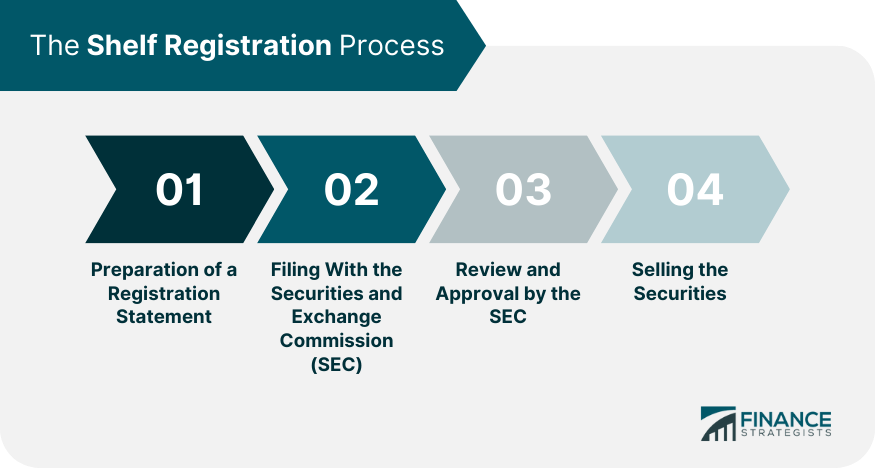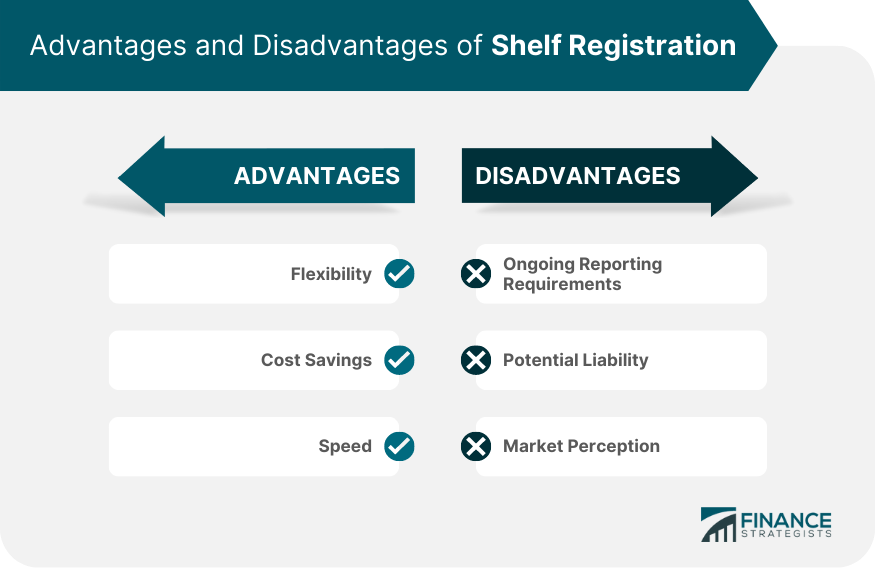Shelf registration is a method of registering securities with the Securities and Exchange Commission (SEC) that allows the issuer to sell securities in multiple offerings over a specified period of time. The registration statement filed with the SEC includes details about the issuer and the securities being offered and becomes effective upon filing. Several types of securities are eligible for shelf registration, including common and preferred stock, bonds, and notes. Shelf registration is an attractive option for companies looking to raise capital quickly and efficiently. With shelf registration, companies can avoid the time and expense of preparing a separate registration statement for each offering. Instead, the registration statement filed with the SEC can be used for multiple offerings over a specified period of time. The primary purpose of shelf registration is to provide issuers with a flexible and cost-effective way to raise capital. By using shelf registration, companies can avoid the time and expense of preparing a separate registration statement for each offering. It also allows issuers to save on costs by eliminating the need to engage in the time-consuming and expensive process of preparing a separate registration statement for each offering. Additionally, the speed and ease of issuing securities through shelf registration make it an attractive option for companies looking to raise capital quickly. Shelf registration provides companies with a simple and straightforward way to raise capital without going through the time and expense of preparing a separate registration statement for each offering. This process allows companies to focus on growing their business rather than spending time and resources on regulatory compliance. Another benefit of shelf registration is its cost savings for the issuer. Companies can save money on legal and accounting fees by eliminating the need to prepare a separate registration statement for each offering. This can be especially important for small and growing companies that are operating on tight budgets. The shelf registration process involves several steps, including preparation of a registration statement, filing with the SEC, review and approval by the SEC, and selling the securities. Preparation of a Registration Statement: The first step in the shelf registration process is preparing a registration statement. This document includes details about the issuer and the securities being offered and is filed with the SEC. Filing With the SEC: Once the registration statement is complete, the issuer must file it with the SEC. The SEC will then review the statement to ensure that it complies with all applicable laws and regulations. Review and Approval by the SEC: The SEC will review the registration statement to ensure that it complies with all applicable laws and regulations. Selling the Securities: After the SEC has approved the registration statement, the issuer can begin selling the securities. This can be done through multiple offerings over a specified period of time, as outlined in the registration statement. Like any financial process, shelf registration has both advantages and disadvantages. It is important for companies to carefully consider these factors before proceeding with shelf registration. Flexibility: One of the biggest advantages of shelf registration is its flexibility. Companies can issue securities in multiple offerings over a specified period of time, allowing them to raise capital as needed. Cost Savings: Shelf registration can also save companies money by eliminating the need to engage in the time-consuming and expensive process of preparing a separate registration statement for each offering. Speed: The speed and ease of issuing securities through shelf registration make it an attractive option for companies looking to raise capital quickly. This can be especially important for companies facing pressing financial needs or opportunities. Ongoing Reporting Requirements: Companies must comply with ongoing reporting requirements after completing a shelf registration. This includes filing periodic reports with the SEC, which can be time-consuming and costly. Potential Liability: Companies must also know the potential liability associated with shelf registration. They may be subject to legal action if they provide false or misleading information in the registration statement. Market Perception: Companies may also be concerned about market perception when using shelf registration. The market may view the frequent issuance of securities through shelf registration as a sign of financial instability. Shelf registration is a method that allows issuers to register securities with the SEC and sell them in multiple offerings over a specific period of time. The primary purpose of shelf registration is to provide companies with a flexible and cost-effective way to raise capital. Shelf registration offers several advantages, such as flexibility, cost savings, and speed. However, there are also disadvantages to consider, including ongoing reporting requirements, potential liability, and market perception. Companies must weigh these advantages and disadvantages to make an informed decision about shelf registration that aligns with their financial goals and circumstances.What Is Shelf Registration?
Purpose of Shelf Registration
The Shelf Registration Process
The registration statement must be complete and accurate and must comply with all applicable laws and regulations.
Companies should be prepared to provide additional information or make changes to the registration statement if requested by the SEC.
This process can take several weeks or even months, depending on the complexity of the registration statement and the workload of the SEC. If the SEC finds any issues with the statement, it may request additional information or change the document.
Companies should be prepared to provide ongoing reporting to the SEC, as the law requires. The shelf registration process provides companies with a flexible and cost-effective way to raise capital.
By eliminating the need to prepare a separate registration statement for each offering, companies can save time and money while still being able to access the capital they need to grow their business.
Advantages and Disadvantages of Shelf Registration
Advantages
This allows companies to respond quickly to changing market conditions and capitalize on opportunities as they arise.
This can be especially important for small and growing companies that are operating on tight budgets.Disadvantages
Companies should be prepared to allocate resources to comply with these requirements.
Companies should take care to ensure that the information in the registration statement is accurate and complete.
Companies should carefully consider the potential impact of shelf registration on their reputation and stock price.
Conclusion
The shelf registration process involves several steps, including the preparation of a registration statement, filing with the SEC, review and approval by the SEC, and selling the securities.
Shelf Registration FAQs
Shelf registration is a process companies use to issue and sell securities by filing a single registration statement with the Securities and Exchange Commission (SEC). This allows companies to sell securities in multiple offerings over a specified period of time, providing them with a flexible and cost-effective way to raise capital.
Common and preferred stock, bonds, and notes are eligible for shelf registration.
The benefits of shelf registration include cost savings, speed and ease of issuing securities, and flexibility for the issuer.
The process of shelf registration involves the preparation of a registration statement, filing with the SEC, review and approval by the SEC, and selling the securities.
The potential disadvantages of shelf registration include ongoing reporting requirements, potential liability, and market perception. Companies should carefully consider these factors before proceeding with shelf registration.
True Tamplin is a published author, public speaker, CEO of UpDigital, and founder of Finance Strategists.
True is a Certified Educator in Personal Finance (CEPF®), author of The Handy Financial Ratios Guide, a member of the Society for Advancing Business Editing and Writing, contributes to his financial education site, Finance Strategists, and has spoken to various financial communities such as the CFA Institute, as well as university students like his Alma mater, Biola University, where he received a bachelor of science in business and data analytics.
To learn more about True, visit his personal website or view his author profiles on Amazon, Nasdaq and Forbes.











